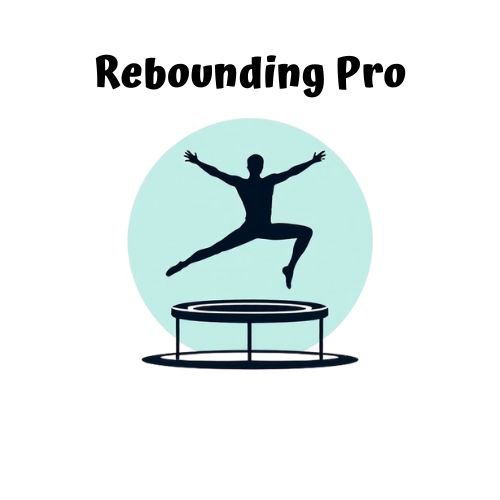Rebounding on a mini-trampoline offers efficient weight loss, burning up to 405 calories in 40 minutes while being 68% more effective than jogging. Start with a 20-minute morning routine of 30-40 second intense bounces followed by 20-second recovery periods. Wear minimal shoes, maintain proper posture, and focus on controlled movements rather than height. Pair your workouts with pre-bounce complex carbs and post-jump protein for ideal results. The journey to transformation begins with your first bounce.
The Science Behind Rebounding for Weight Loss

While traditional cardio exercises often get the spotlight, rebounding on a trampoline delivers impressive weight loss results through unique physiological mechanisms. Your body burns approximately 405 calories during a 40-minute session if you weigh 140 pounds, with even short 15-minute daily workouts accumulating 820 calories over ten days.
What makes rebounding twice as aerobically efficient as running is the amplified G-force effect. Each bounce stimulates your lymphatic system, enhances fat oxidation, and engages your entire body simultaneously. NASA research has shown rebounding to be up to 68% more effective than jogging at 9 km/h.
You’ll experience improved VO₂ max comparable to running while enjoying considerably less joint stress.
The combination of aerobic and anaerobic adaptation supports sustainable weight loss by reducing body fat percentage, improving your BMI, and balancing hormones through enhanced lymphatic activity—all while feeling more enjoyable than traditional cardio.
Baseline Measurements: Track Your Progress Journey
Before jumping into your trampoline workout routine, establishing accurate baseline measurements creates the foundation for tracking your transformation journey.
Take measurements while barefoot in minimal clothing, using the same digital scale and tape measure each time.
For accurate progress tracking, measure barefoot in minimal clothing with consistent measuring tools every time.
Focus on five key areas: bust, waist, hips, thighs, and arms.
For consistency, measure under similar conditions—same time of day, clothing, and hydration levels.
Schedule bi-weekly or monthly check-ins rather than daily weigh-ins which can be discouraging. Remember that the scale doesn’t tell the complete story as muscle is denser than fat tissue, which can mask actual progress in body composition.
Essential Gear for Safe and Effective Rebounding

Now that you’ve established your baseline measurements, let’s outfit you properly for your rebounding journey.
Choose a rebounder with a sturdy frame that’s at least 9 inches tall and weighs over 10 kilograms to guarantee stability during your workouts. For optimal durability, look for rebounders with high-quality steel frames. Always verify it has proper safety certifications.
For clothing, opt for minimalist shoes like gymnastics or dance footwear that offer protection while maintaining sensitivity.
Wear fitted, moisture-wicking fabrics that won’t restrict movement or cause distractions. Women should use high-impact sports bras, while men benefit from compression shorts.
Consider accessories like handle bars for balance and weighted gloves to increase intensity.
Set up your rebounder on a stable surface with adequate surrounding space, and regularly inspect it for wear.
For convenience, foldable models offer easy storage between workouts.
20-Minute Morning Metabolism Igniter Routine
To jumpstart your day with maximum metabolic impact, this quick-fire morning routine transforms mere minutes into powerful fat-burning sessions.
Start with 10 deep nasal breaths to prime your nervous system before launching into 4-5 circuits of 30-40 second high-intensity bounces followed by 20-second recovery periods.
Begin with 10 deep nasal breaths, then power through 4-5 rounds of 30-40 second intense bounces with 20-second rest intervals.
Engage your core by tightening your transverse abdominals and pelvic floor during each bounce. Incorporate hip twisting movements while sinking slightly into your stretches to maximize core engagement. Pair arm pumping motions with lateral foot shifts to enhance muscle recruitment and calorie burn.
For best results, practice in a fasted state each morning, aiming for 5-12 minutes total.
Monitor your heart rate (target 70-85% of maximum) and track perceived exertion to guarantee proper intensity. If needed, modify with baby bounces or seated variations while maintaining the HIIT protocol structure.
Advanced HIIT Sequences for Maximum Fat Burning

Your trampoline transforms into a fat-melting powerhouse when you implement 40/20 intervals with compound movements that specifically target stubborn belly fat.
Increase your calorie burn by gradually progressing from moderate (L3) to maximum effort (L5) intensity bursts, incorporating multi-planar movements that engage your core while maintaining soft landings.
You’ll maximize your results by incorporating strategic recovery-boosting bounce techniques between high-intensity segments, allowing for sustained effort while triggering the essential 24-48 hour afterburn effect. For optimal effectiveness, integrate five basic movements designed to elevate intensity while keeping the workout accessible for all fitness levels.
Torch Stubborn Belly Fat
While countless workout programs promise to eliminate belly fat, advanced HIIT sequences on a trampoline truly deliver exceptional results. The combination of plyometric movements with the trampoline’s low-impact surface creates a perfect environment for targeting stubborn midsection fat.
For maximum belly fat reduction, incorporate these core-intensive exercises:
- Alternating Mountain Climbers – Perform 30 seconds of rapid knee drives while in plank position on the trampoline’s edge to engage deep abdominal muscles.
- Touchdown Jack Intervals – Complete 45-second bursts with full extension jumps, reaching for the sky then touching the trampoline.
- Spider Plank Rotations – Hold side planks while performing controlled twisting movements that target obliques and transverse abdominals.
These exercises elevate your metabolism for hours afterward, burning calories even when you’re resting. Remember to maintain clean form throughout your workout to maximize effectiveness and prevent potential injuries.
Progressive Intensity Intervals
Progressive intensity intervals represent the pinnacle of trampoline-based fat loss training, combining explosive movements with strategic recovery periods for unparalleled calorie burn.
Structure your intervals with 20-45 seconds of maximum effort followed by 10-30 seconds of active recovery to maintain elevated heart rates throughout.
For exceptional results, try Tabata protocol: 20 seconds all-out effort, 10 seconds rest, repeated eight times.
Incorporate squat jumps, tuck jumps, and sprints to maximize intensity. Always remember to push through heels during squat movements to properly engage your lower body muscles while maintaining core stability. You’ll engage both aerobic and anaerobic energy systems while enjoying the low-impact nature of rebounding.
Take your workout to the next level by adding hand weights or resistance bands.
These weighted elements increase muscular engagement and calorie expenditure, creating a perfect hybrid of cardio and strength training that accelerates fat loss while building lean muscle.
Recovery-Boosting Bounce Techniques
Beyond the intense calorie burn of standard rebounding exercises, recovery-boosting bounce techniques offer a strategic advantage for serious fitness enthusiasts.
These methods specifically target lymphatic system activation, accelerating post-workout recovery while maintaining metabolic benefits.
Incorporate these recovery-focused techniques into your routine:
- Perform 10-15 minutes of light bouncing immediately after intense workouts to flush metabolic waste and reduce muscle soreness.
- Add “monster jumps with arm openers” to stimulate upper body lymph circulation while maintaining cardiovascular engagement.
- Alternate gentle heel taps with controlled movements as an effective cool-down sequence that normalizes heart rate while continuing lymphatic drainage.
On active rest days, try 20-minute moderate sessions focused on lymphatic stimulation without causing additional fatigue—you’ll recover faster while still burning calories. The gentle nature of rebounding makes it an ideal exercise choice for maintaining fitness while allowing the body to heal, as it’s low-impact on joints compared to traditional high-intensity workouts.
Recovery Bounce: Low-Impact Sessions for Rest Days
After intense trampoline workouts, your body needs time to recover without completely halting your fitness routine. Low-impact rebounding offers the perfect solution, promoting lymphatic drainage and cardiovascular health while giving your joints a break.
On rest days, focus on gentle techniques like controlled heel pushes, light bounces, and squat combinations that engage your muscles without strain. Try incorporating the basic bounce technique with feet shoulder-width apart, hands on hips, and a slight bend in the legs to maintain proper form. Incorporate static holds to improve balance and let your arms swing freely for rhythm.
Always warm up properly, maintain correct posture, and stay hydrated. Structure your recovery sessions into 15-20 minute circuits with adequate rest periods.
Mix different low-impact moves to keep things interesting while giving your body time to heal. Choose a quality mini trampoline with even resistance for ideal safety and performance.
Nutritional Pairings to Enhance Rebounding Results
Your nutrition choices can make or break your trampoline workout results, with proper fueling before and after sessions dramatically improving performance and recovery.
Before bouncing, opt for complex carbohydrates paired with moderate protein to sustain energy levels without causing digestive discomfort.
After your session, consume 20-30g of protein within an hour, alongside carbohydrates and electrolytes, to maximize muscle repair and replenish depleted glycogen stores.
For optimal results, incorporate cardiovascular health benefits by maintaining consistent rebounding sessions that complement your nutritional strategy.
Pre-Bounce Fuel Options
What you eat before stepping onto your trampoline can dramatically affect your workout quality and results. Timing is essential—aim to eat a light meal 1-2 hours before rebounding to prevent discomfort while ensuring adequate energy.
Choose low to moderate glycemic index foods for stable energy throughout your bounce session.
For ideal pre-trampoline nutrition, consider these power-packed options:
- Quick Energy Combo – Half a banana with a tablespoon of almond butter provides potassium for muscle function and healthy fats for sustained energy.
- Balanced Mini-Meal – Small portion of oatmeal topped with berries offers complex carbs and antioxidants without weighing you down.
- Hydration Plus – Green smoothie with spinach, apple, and ginger delivers nutrients while supporting inflammation reduction and proper hydration. Proper nutrition complements your workout and helps your body stay in dynamic rhythm with the music during your trampoline exercises.
Post-Jump Recovery Nutrition
Once your trampoline workout ends, the real transformation begins inside your body. Maximize these benefits by consuming a balanced snack within 60 minutes that combines protein and carbohydrates.
Aim for 6-8 carb servings and 2-3 protein servings throughout your day. Include complex carbohydrates like oats or sweet potatoes paired with quality proteins to repair muscle tissue and replenish glycogen stores. Consuming 20-30 grams of protein per meal provides optimal results for muscle recovery after your trampoline exercise.
Don’t forget to rehydrate properly—water alone isn’t enough after intense sessions. Incorporate electrolyte-rich foods containing potassium, calcium, and magnesium to support muscle function.
For ideal results, consider the timing of your nutrients as vital as the composition. This synergistic approach enhances recovery, supports bone health from high-impact jumping, and helps maintain energy levels while promoting the metabolic benefits of your rebounding routine.
Common Form Mistakes That Limit Calorie Burning
While trampoline workouts offer exceptional calorie-burning potential, several common form mistakes can substantially reduce their effectiveness. Your jumping direction matters greatly—aiming down with controlled force rather than up aggressively guarantees proper muscle engagement and maximizes energy efficiency.
- Jumping too high – Keep your feet close to the mat for consistent resistance, better balance, and sustained heart rate elevation. Small, quick bounces burn more calories than high leaps. Positioning your weight in your heels, not toes creates a more stable foundation and properly activates your posterior chain muscles.
- Poor posture – Maintain shoulders back, spine neutral, and core engaged. Slouching limits breathing capacity and reduces endurance.
- Uncontrolled movements – Bouncing without rhythm wastes energy and decreases muscle activation. Focus on controlled, even-tempo movements to maintain workout intensity and prevent premature fatigue.
Progressive 30-Day Rebounding Challenge Calendar
Ready to transform your fitness routine with structured trampoline workouts? Our 30-day rebounding challenge progressively builds your stamina and skills while keeping workouts fun and effective.
Week 1 focuses on mastering basic form with 10-minute sessions, teaching fundamental movements before advancing. Designed to accommodate all fitness levels, this initial phase ensures everyone can participate regardless of previous exercise experience.
Weeks 2-3 introduce varied cardio and strength components, gradually increasing intensity through jump height and speed modifications. By week 4, you’ll combine everything for thorough full-body workouts.
Each day alternates between cardio-focused and strength-enhanced rebounding, with strategic rest days following the LTYB (Listen To Your Body) approach.
Remember, just 10 minutes on your rebounder equals approximately 30 minutes of traditional cardio!
Track your progress using downloadable plans and supplement with online videos for proper technique guidance.
Frequently Asked Questions
Can Seniors With Mobility Issues Safely Use Trampolines for Weight Loss?
Yes, you can safely use trampolines if you have mobility issues. Choose models with handles for stability, start with gentle bounces, and always consult your physician first. The low-impact nature benefits joint health.
How Do I Prevent Hair Loss From Frequent Bouncing and Sweating?
To prevent hair loss while bouncing, wear a protective cap, stay hydrated, do post-workout scalp massages, and maintain a balanced diet. Don’t tie your hair too tight and clean your scalp properly after sweating.
Will Trampoline Workouts Cause Facial Skin Sagging Over Time?
No, trampoline workouts won’t cause facial sagging. They actually improve circulation and may boost collagen production. Maintain your skin health by staying hydrated and using proper skincare while enjoying the benefits of rebounding.
Can Rebounding Help Reduce Cellulite Appearance Specifically?
Yes, rebounding can help reduce cellulite appearance. You’ll benefit from improved lymphatic drainage, enhanced circulation, muscle toning, and fat reduction – all contributing factors that diminish the dimpled texture of cellulite over consistent practice.
Are There Weight Limits for Different Trampoline Types and Brands?
Yes, weight limits vary considerably by trampoline type and brand. You’ll find rebounders supporting up to 600 pounds, mini trampolines handling 100-330 pounds, and backyard models ranging from 175-500+ pounds depending on size and construction.
In Summary
You’ve now got everything you need to transform your body through rebounding. Start small, stay consistent, and watch your results multiply. Remember, it’s the combination of your daily bounces, proper nutrition, and gradual progression that creates lasting change. As you continue your 30-day challenge, you’ll not only shed pounds but discover a sustainable fitness habit you’ll actually enjoy maintaining.





Leave a Reply